
Cryptandra is a genus of flowering plants family Rhamnaceae and is endemic to Australia. Most plants in the genus Cryptandra are spiny, heath-like shrubs with small, clustered leaves and flowers crowded at the ends of branches, the flowers usually small, surrounded by brown bracts, and with a tube-shaped hypanthium, the petals hooded over the anthers.
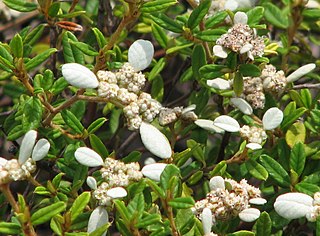
Spyridium is a genus of about thirty species of flowering plants in the family Rhamnaceae, and is endemic to Australia. Plants in the genus Spyridium are shrubs or subshrubs usually with small leaves, flowers usually in clusters of small composite heads, the individual flowers small and densely woolly-hairy, and the fruit a capsule. Species of Spyridium are found in all Australian states except Queensland.

Gompholobium huegelii, commonly known as common wedge-pea is a species of flowering plant in the family Fabaceae and is endemic to south-eastern Australia. It is an erect or spreading shrub with trifoliate leaves and cream-coloured to yellow and greenish, pea-like flowers.
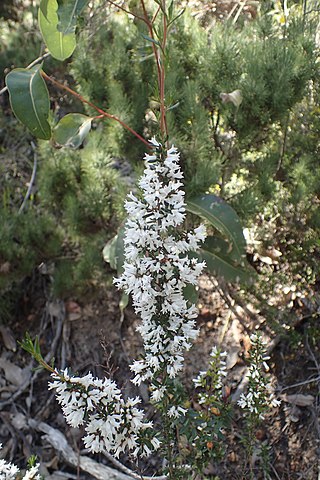
Cryptandra arbutiflora, commonly known as waxy cryptandra, is a species of flowering plant in the family Rhamnaceae and is endemic to the southwest of Western Australia. It is a shrub with spiny branches, elliptic to linear leaves and tube-shaped white flowers.

Pomaderris ferruginea, commonly known as rusty pomaderris, is a species of flowering plant in the family Rhamnaceae and is endemic to south-eastern continental Australia. It is a shrub with rusty-hairy stems, egg-shaped leaves, and clusters of cream-coloured, whitish or yellow flowers.

Darwinia vestita, commonly known as pom-pom darwinia, is a species of flowering plant in the family Myrtaceae and is endemic to the southwest of Western Australia. It is an erect, bushy shrub with crowded egg-shaped, oblong, or linear leaves and more or less spherical heads of white to reddish-pink flowers.
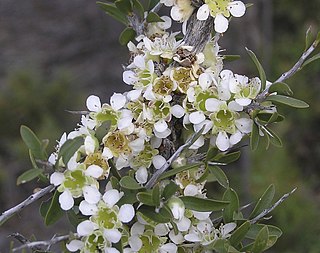
Leptospermum spinescens, commonly known as the spiny tea tree, is a species of spiny shrub that is endemic to Western Australia. It has thick, egg-shaped to elliptical leaves on a short petiole, white or greenish cream flowers, and fruit that remain in the plant for years after reaching maturity.

Daviesia divaricata, commonly known as marno, is a species of flowering plant in the family Fabaceae and is endemic to the south-west of Western Australia. It is a low, spreading or erect and bushy shrub with phyllodes reduced to small, triangular scales, and orange and maroon flowers.
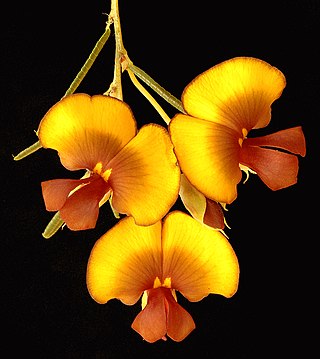
Bossiaea eriocarpa, commonly known as common brown pea, is a species of flowering plant in the family Fabaceae and is endemic to the south-west of Western Australia. It is a shrub with narrow oblong or linear leaves and yellow and red flowers.

Pomaderris prunifolia, commonly known as plum leaf pomaderris, is a plant in the family Rhamnaceae. It has slightly toothed, wrinkled green leaves, stems with rusty coloured star-shaped hairs and yellow flowers.

Goodenia fasciculata is a species of flowering plant in the family Goodeniaceae and is endemic to the south-west of Western Australia. It an ascending shrub with bunched, narrow linear stem leaves and spikes of white flowers.

Goodenia pulchella is a species of flowering plant in the family Goodeniaceae and is endemic to the south-west of Western Australia. It is an erect to ascending herb with lance-shaped leaves mostly at the base of the plant, and racemes of yellow flowers.

Kennedia carinata is a species of flowering plant in the family Fabaceae and is endemic to the south-west of Western Australia. It is a prostrate shrub with trifoliate leaves and reddish-purple, pea-like flowers.
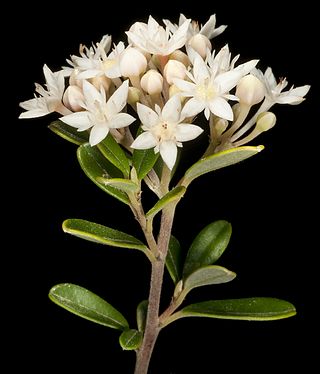
Pomaderris myrtilloides is a species of flowering plant in the family Rhamnaceae and is endemic to near-coastal areas of southern Western Australia. It is an erect shrub with many branches, narrowly egg-shaped elliptic or wedge-shaped leaves with the narrower end towards the base, and cream-coloured to pale pink flowers.

Pomaderris obcordata, commonly known as wedge-leaved pomaderris, is a species of flowering plant in the family Rhamnaceae and is endemic to South Australia. It is a shrub with densely hairy branchlets, wedge-shaped, narrowly egg-shaped or heart-shaped leaves with the narrower end towards the base, and white to pink flowers.
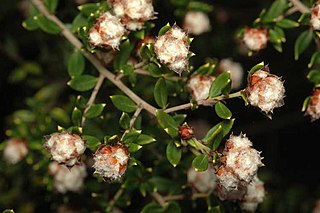
Spyridium buxifolium is a species of flowering plant in the family Rhamnaceae and is endemic to New South Wales. It is a spreading shrub with egg-shaped to elliptic leaves, and heads of white, softly-hairy flowers with brown bracts at the base of the heads.

Spyridium eriocephalum, commonly known as heath spyridium or heath dustymiller, is a species of flowering plant in the family Rhamnaceae and is endemic to south-eastern Australia. It is an erect to spreading shrub with linear leaves, and heads of white or cream-coloured, woolly-hairy flowers with brown bracts at the base.
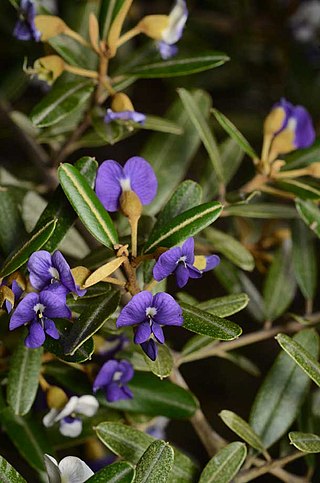
Hovea longipes is a species of flowering plant in the family Fabaceae and is endemic to north-eastern Australia. It is a shrub or tree with narrowly elliptic to lance-shaped leaves, and deep indigo-blue and white, pea-like flowers.

Spyridium spadiceum is a species of flowering plant in the family Rhamnaceae and is endemic to the south of Western Australia. It is an erect or semi-prostrate shrub with narrowly oblong to oval leaves and heads of hairy flowers with brown bracts at the base.
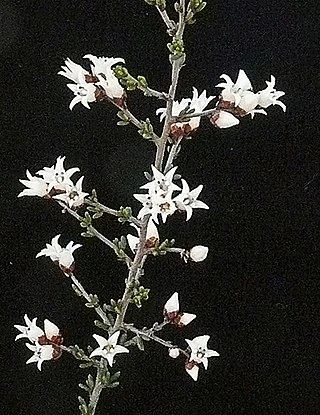
Cryptandra magniflora is a species of flowering plant in the family Rhamnaceae and is endemic to Victoria (Australia). It is a shrub with cylindrical leaves, and clusters of white, tube-shaped flowers.




















